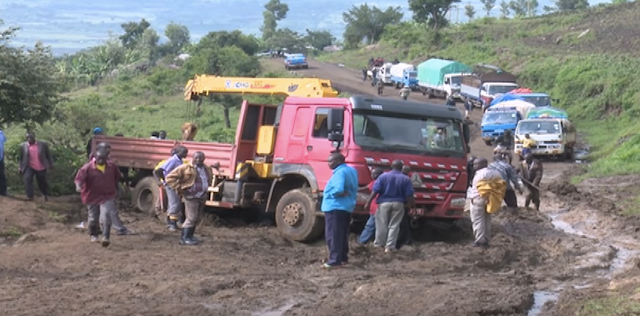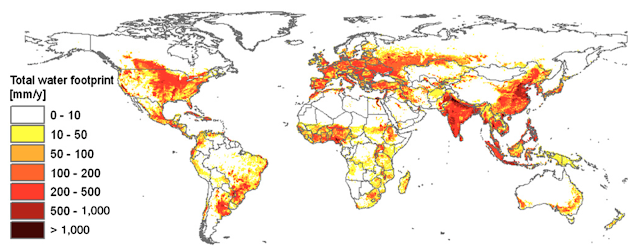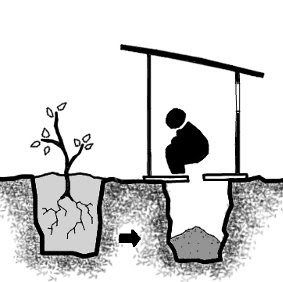Building Roads: Connecting Farmers and Markets
Kapchorwa Roads (Source: NTV)
On the other hand, smooth tarmac roads built that connects Kenyan farmers in Central Rift of Kenya and local markets like Nairobi have improved agricultural revenue. The next video below shows how improved roads benefits agriculture through local interviews.
The above accounts for two simple and contrasting scenarios in which well-built roads can have drastic impacts on market access. In sub-Saharan Africa, despite great potential for agriculture, many arable lands remains unused due to factors such as limited transport access (Chamberlin et al., 2014). This is advanced by Berg et al. (2018) who concludes that improving market access increases land cultivation and local GDP. The research also suggests that market access is connected with agricultural expansion and intensification. In a way, this highlights that transport developments facilitate the shift from rural or subsistence to commercial agriculture (Gollin & Rogerson, 2014) This can be through a myriad of other contributing factors that facilitates increase productivity (Kiprono and Matsumoto, 2014) accompanying improvements in transport, improving inputs and outputs.
With only 34% of rural Africans living within 2km of an all-season road, there is a clear opportunity to improve rural access to improve rural agriculture. But is building roads just enough? Roads serve as a double-edged sword in Africa’s agricultural developments and thus it is relevant to consider the negative impacts of road provisions. Berg et al. (2018) also noticed that increasing market access can accelerate the reduction of existing shrinking agricultural areas and postulates that these might be due to outmigration or development of non-agricultural activities. In addition, roads can have negative environmental consequences such as increased surface runoff, flooding, erosion, and impacts waste resources and hazards (Demenge et al., 2014) which in turn may affect rural communities based on case study of Tigray in Ethiopia.
With innovative solutions such as the “Roads for Water”, developers are looking to turn the tide against negative environmental impacts of roads while at the same time using roads as tools for water harvesting (Woldearegay, 2015) with proper planning to channel water away or for storage. This creates productive and resilient infrastructures that help communities in building climate resilience while addressing road damage and reducing disruptions as a result of events like flooding.
Not forgetting citrus agriculture which is a theme of this blog, a comparative case study on citrus farms in the Tanga Region of Tanzania shows that proximity of farms to roads affects farmers profits. Large and medium scale citrus farmers with close proximity to roads have greater bargaining power and better profits compared to small-scale farmers which are further (Izamuhaye, 2008). This could be due to an advantageous position providing farmers convenience and ease of exporting oranges faster before deterioration as well as reducing transport cost. Interestingly, studies also show that fruit damage on tangerines, for example, can be greatly reduced with transport over asphalt road surfaces (Bundit et al., 2005). Therefore, this emphasizes that the quality of roads also plays a trivial role in prolonging value of agricultural commodities.
Looking back at the Kat Valley case study can also help illuminate that roads also serve as essential instruments in connecting stakeholders. This is especially in the process embedded in Integrated Catchment Management. For example, it is difficult for some community stakeholders to attend Catchment Management Forums for the Kat Catchment as they face obstacles such as poorly serviced roads (Simpungwe, 2006). This may inevitably impact on the willingness of stakeholders to attend and partake in negotiations of water use in the catchment.
In examining some of the relevant narratives, I hope to elicit that roads are key to agricultural and economic development and while overall being beneficial, it also has negative aspects that can be addressed with technological solutions yielding positive outcomes. Roads are paramount for rural development that relies on agriculture as the engine of growth because roads serve the primary function as conduits for flows of agricultural goods in commodity chains. As much as increasing road access to rural agricultural communities is vital, quality and types of roads, the proximity of agricultural communities to roads and other factors(that may not be covered) are no less important. However, roads as a materialized form of agricultural investment may result in highly uneven rural landscapes where small-scale farmers or communities may be marginalized. Therefore, it is important for rural road development programs to take into account its potential development impacts on various stakeholders and users of the infrastructure.








Hey there!
ReplyDeleteThis is a fascinating post! In my blog I have mainly focused on how water influences the production of food, but considering how changing rainfall patterns e.g. affect transportation of goods in a new paerspective! I find it particularly interesting how roads can be seen as development indicators enabling remote farms to become part of the global market! You also mentioned that roads can be used as a means of water harversting. How exactly does that work? Is that actively promoted by local governments?
Hello Alina! Thank you for reading this post. Briefly, roads can be used as means of water harvesting through a range of structural mitigation infrastructures embedded on roads and around it. These infrastructures seek to optimise the road development process and boost recharge and retention of water resources in various regions and can be developed to be compatible with existing environment and road conditions. In addition, infrastructures do not need to be very technical and can be simple and effective. These infrastructures can range from very simple to construct features like hand dug channels and bunds to more technical or larger infrastructures like polders, elevated roads or bridges.
DeleteThese infrastructures can include but are not limited to (Woldearegay et al. 2015):
1) Channels and trenches for water to flow away from roads and culverts (diverting away from roads to storage or to farms)
2) Water storage ponds, Hand-dug wells, Borrow puts
3) Check-dams
Water harvesting techniques embedded in roads take into consideration the importance of good drainage. At the same time, other benefits include reducing gullies formation and reducing soil erosion due to roads water runoffs.
It is difficult to visualize these structural mitigations and I would encourage watching the following short video pitch from “Roads for Water”: https://vimeo.com/135438781 . (They also have a series of videos on their official website)
There is also a handout I found on the internet with regards to some of the possible road water harvesting techniques: https://www.viawater.nl/files/attachments/community_post_comments/technical_hand_out_rfw_-_kenya.pdf
Or some images (Without getting too technical):
http://roadsforwater.org/wp-content/gallery/infographics/Solution-Statement_Infographics-5.jpg
Currently, “Roads for Water” hopes to achieve by 2025 that at least half of the roads in Africa are water buffered. For the project to be successful, I strongly believe that local government and road developers’ involvement are very crucial for scaling it up. For example, in Tigray (Ethiopia) mentioned in this post, some water harvesting projects have been financed by the government (Tigray Bureau of Agriculture and Rural Development) (Woldearegay et al. 2015).
In my opinion, I think the project is promising considering its benefits and hopefully it will be promoted further and more actively by local governments and other stakeholders (farmers, road users, catchment management etc.).
Other references:
Woldearegay, K., van Steenbergen, F., Perez, M. A., Grum, B., & van Beusekom, M. (2015). Water Harvesting from Roads: Climate Resilience in Tigray, Ethiopia. IRF, 1.
(Apologies in advance that I'm unable to insert hyperlinks in the comments)
Thank you for reading again! =D
I thought this post was rather intriguing as it never occured to me that roads played such an important role in the development of water management strategies. I was about to ask you the question that Alina posted above, but your reply is really comprehensive. I was just wondering if the marginalisation of small scale farmers also extends to the implementation of water harvesting strategies through roads, and if there have been any impetus by the local authorities to account for their presence, and perhaps their influence, albeit small, on the overall agricultural industry? Thanks again for writing this piece!
ReplyDeleteHello Eva! Did you mean that small-scale farmers may not be able to benefit from the implementation of water harvesting strategies on roads? Or perhaps they are neglected and do not stand to benefit even if there are water harvesting strategies on some roads.
DeleteWell although I have not come across literature hitherto that highlights the potential which water harvesting strategies fail to benefit small-scale farmers causing them to be "marginalised" again (because this is still 'new' and being explored), I think that is a very good question to ponder about. In the same way the proximity of roads to certain farms can have greater benefits to adjacent communities, I would postulate that communities closer to the implementation of water harvesting roads will be more advantageous.
If I were to think about large scale water harvesting solution for roads (e.g. creating polders and large bridge), as stakeholders implementing or investing in a road infrastructure , I guess it would be wiser to target and upgrade main roads near or adjacent to profitable or large scale export oriented agriculture compared to smallholder farms. Water harvested may also be primarily focused and channeled to large scale farms rather than smallholder farms . In other words, smallholder farms may also not have the capacity to invest in such solutions compared to large scale farms. Nonetheless, some simple techniques can still be implemented on rural roads connecting smallholder farms if they can get access to resources or are educated on the best possible way to utilise the roads to their benefits.
At the same time, there potential solutions such as water user associations (WUA) and IWRM which are platforms in which smallholder farms can also negotiate their demands for water resources available. Hence, there could be fair opportunities to have their presence equally represented. (Ideally, although that might not be the case)
Thank you! =D